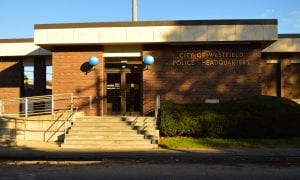WESTFIELD –When the White Street Crime Watch Group was founded in 2007 it was one of several active in the city but, five years later, is stands alone as the only group of neighbors still meeting and working to protect their neighborhood.
The reason the group is still effective is not because of aggressive patrols of the neighborhood but because members of the group have worked to unite the residents with tools such as block parties and community activities.
Westfield Police Capt. Michael McCabe, a teacher in the criminal justice department at Westfield State University, said that the type of crime the residents of the area experience can be effectively controlled by residents simply keeping an eye on their neighborhood so events which bring residents together, such as a recent community movie night, are effective ways to control crime.
“The better you know your neighbors the more likely your neighbors are to protect one another. It’s that simple” McCabe said.
The group is lead by block captain Dawn Sienkiewicz who said that the group was formed at the suggestion of Community Policing Officer Stephan Dickinson at a time when there had been a rash of brazen breaking and entering crimes in the neighborhood.
Sienkiewicz said that she and other residents of White Street, Dubois Street, Cherry Street, North Cherry Street and Hamlin Place who started the group found a great deal of information that was helpful on a web site that the community policing officers told her about.
She said that the web site suggested that, in order to be an active crime watch group, the participants should meet at least three times a year and stage a community event every year.
The advice was sound, Sienkiewicz said, because getting together, both for meetings and for the events the group staged, worked to cement a sense of community in the neighborhood.
She said that, in the five years since the group started, the members have staged a block party, a community cleanup, a food drive for the nearby food pantry and, most recently, a neighborhood movie night.
Both Sienkiewicz and McCabe agree that it is the social aspects of the crime watch group which have kept it together and what actually provides protection for the neighborhood.
“When we started in ’07, I think there were eight group, eight different crime watch groups, and now, here we are. We’re the only one left because what ends up happening is, when the crime gets ‘fixed’, people are no longer interested” Sienkiewicz said.
McCabe said that crime watch groups are usually formed because of a specific event such as a rash of crimes in a neighborhood. He said “Once that rash or crime streak goes away, the interest in the crime watch also goes away” which is what happened when the crimes in, for example, the Orange Street or Prospect Street areas, were brought under control.
The original problem was resolved in the White Street neighborhood when the person who had been breaking into houses was caught but, because of the community involvement fostered by the White Street group, that group has prospered and continued.
“Increasing involvement within our neighborhood equals (a) safer more secure neighborhood” Sienkiewicz said. “It’s the most effective thing that deters crime. When they know that the neighborhood’s watching out for each other, they kind of stay away” she said.
McCabe said that there is not a lot of serious crime in the neighborhood but the crime watch group is effective with quality of life issues such as abandoned cars, broken windows or overgrown sidewalks.
Sienkiewicz said that, while the group does not regularly patrol their neighborhood, members will regularly walk with their dogs and keep an eye on the neighborhood. And, if something untoward is seen, the group has set up a “phone tree” so news of a problem can be promptly disseminated.
Sienkiewicz said that one big reason for the group’s success is that the members have learned to call police without hesitation when there is something to report.
“That was kind of my motto the first few years – ‘Don’t be afraid to pick up the phone’” Sienkiewicz said. “The cops can’t do anything about what’s going on down here if you don’t let them know what’s going on.”
She said that for concerns which don’t require a police response, “We all have each other’s phone numbers so, if we see something amiss, we can call each other” to alert neighbors of suspicious persons or any other causes for concern in the neighborhood.
For example, she said, for a time three years ago it appeared that persons were using drugs in the Mt. Meadow School parking area so the neighbors began using the parking area for “doggie play time in the school yard just to deter them from hanging around in there.”
Because the group is effective in fostering neighborhood interest, it is very stable with almost all of the original members still active.
Sienkiewicz said that her group’s area encompasses 95 homes and said that she still has 15 very active members who have been with the group since the beginning. She said that, in the group’s five year history, only four members have dropped out “and two of them were because they moved down South.”
Siekiewicz stressed that the crime watch is a group effort, “I couldn’t do it without everybody else.”
She said that she get substantial support from the group’s three block lieutenants – Lou Faldon for Cherry Street, Sherry Zalewa for Dubois Street and Susan Janisiewski for the lower end of White Street.
“I don’t do this alone” she said.



